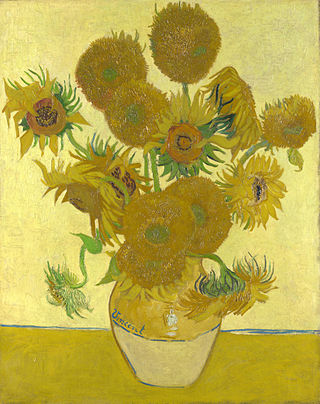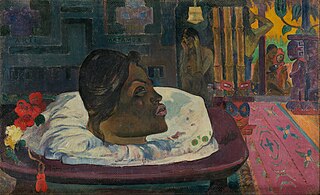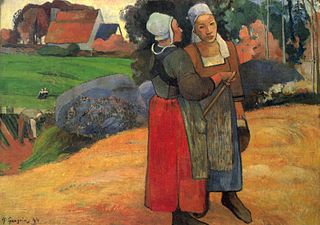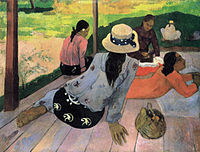
Eugène Henri Paul Gauguin was a French Post-Impressionist artist. Unappreciated until after his death, Gauguin is now recognized for his experimental use of colour and Synthetist style that were distinct from Impressionism. Toward the end of his life, he spent ten years in French Polynesia. The paintings from this time depict people or landscapes from that region.

Pierre Bonnard was a French painter, illustrator and printmaker, known especially for the stylized decorative qualities of his paintings and his bold use of color. A founding member of the Post-Impressionist group of avant-garde painters Les Nabis, his early work was strongly influenced by the work of Paul Gauguin, as well as the prints of Hokusai and other Japanese artists. Bonnard was a leading figure in the transition from Impressionism to Modernism. He painted landscapes, urban scenes, portraits and intimate domestic scenes, where the backgrounds, colors and painting style usually took precedence over the subject.

Where Do We Come From? What Are We? Where Are We Going? is a painting by French artist Paul Gauguin. The painting was created in Tahiti, and is in the Museum of Fine Arts in Boston, Massachusetts. Viewed as a masterpiece by Gauguin, the painting is considered "a philosophical work comparable to the themes of the Gospels".

Sunflowers is the title of two series of still life paintings by the Dutch painter Vincent van Gogh. The first series, executed in Paris in 1887, depicts the flowers lying on the ground, while the second set, made a year later in Arles, shows a bouquet of sunflowers in a vase. In the artist's mind, both sets were linked by the name of his friend Paul Gauguin, who acquired two of the Paris versions. About eight months later, Van Gogh hoped to welcome and impress Gauguin again with Sunflowers, now part of the painted Décoration for the Yellow House that he prepared for the guestroom of his home in Arles, where Gauguin was supposed to stay. After Gauguin's departure, Van Gogh imagined the two major versions as wings of the Berceuse Triptych, and finally, he included them in his Les XX in Bruxelles exhibit.

L'Arlésienne, L'Arlésienne : Madame Ginoux, or Portrait of Madame Ginoux is the title given to a group of six similar paintings by Vincent van Gogh, painted in Arles, November 1888, and in Saint-Rémy, February 1890. L'Arlésienne means literally "the woman from Arles".

Paul Sérusier was a French painter who was a pioneer of abstract art and an inspiration for the avant-garde Nabis movement, Synthetism and Cloisonnism.

Landscape near Arles is an 1888 oil painting by French artist Paul Gauguin depicting a rural scene in Provence. It is currently located in the Indianapolis Museum of Art in Indianapolis, Indiana.

Memory of the Garden at Etten (Ladies of Arles) is an oil painting by Vincent van Gogh. It was executed in Arles around November 1888 and is in the collection of the Hermitage Museum. It was intended as decoration for his bedroom at the Yellow House.

Self-Portrait with Halo and Snake, also known as Self-Portrait, is an 1889 oil-on-wood painting by French artist Paul Gauguin, which represents his late Brittany period in the fishing village of Le Pouldu in northwestern France. No longer comfortable with Pont-Aven, Gauguin moved on to Le Pouldu with his friend and student Meijer de Haan and a small group of artists. He stayed for several months in the autumn of 1889 and the summer of 1890, where the group spent their time decorating the interior of Marie Henry's inn with every major type of art work. Gauguin painted his Self-Portrait in the dining room with its companion piece, Portrait of Jacob Meyer de Haan (1889).

Arii Matamoe or The Royal End is a painting on coarse cloth by the French artist Paul Gauguin, created in 1892 during the painter's first visit to Tahiti. It depicts a man's severed head on a pillow, displayed before mourners, and although it did not depict a common or contemporary Tahitian mourning ritual, may have been inspired by the death of Pōmare V in 1891 shortly after Gauguin's arrival. A curator for the J. Paul Getty Museum suggested Gauguin likely painted the canvas "to shock Parisians" upon his expected return to the city.

Aha Oe Feii? or Are You Jealous? is an oil-on-canvas painting by Paul Gauguin from 1892, based on a real-life episode during his stay on Tahiti which he later described in the diary Noa Noa: "On the shore two sisters are lying after bathing, in the graceful poses of resting animals; they speak of yesterday's love and tomorrow's conquests. The recollection causes them to quarrel, "What? Are you jealous?" Gauguin titled the painting in Tahitian language, Aha Oe Feii?, in the lower left corner of the canvas.
Today the term South Seas, or South Sea, is used in several contexts. Most commonly it refers to the portion of the Pacific Ocean south of the equator. In 1513, when Spanish conquistador Vasco Núñez de Balboa coined the term Mar del Sur, or South Sea, the term was applied to the entire area of today's Pacific Ocean. In 1520 Ferdinand Magellan named the same ocean the Pacific Ocean, and over time Magellan's name became dominant. The South Sea term was retained, but was applied only to southern areas of the Pacific.

Eiaha Ohipa is an 1896 oil on canvas painting by Paul Gauguin, now in Pushkin Museum, Moscow. It was produced during his second stay in Tahiti

Portrait of Madame Roulin is an oil on canvas portrait by Paul Gauguin of Augustine Roullin, wife of the postman Joseph Roulin (1841-1903). It is now in the St Louis Museum of Art.

Breton Peasant Women is an 1894 oil on canvas painting by Paul Gauguin of two Breton peasant women in conversation. It is now in the Musée d'Orsay in Paris.

Parau na te varaua ino is an 1892 oil on canvas painting by Paul Gauguin, produced during the artist's first stay on Tahiti. It is now in the National Gallery of Art

Nevermore is an 1897 oil on canvas painting by the French Post-Impressionist artist Paul Gauguin. Since 1932 it has been in the collection of the Courtauld Institute of Art and on display in the Gallery. It was executed during the artist's second stay on the island of Tahiti in the South Pacific.

The Siesta is an oil on canvas painting by Vincent van Gogh painted between December 1889 and January 1890 while he was interned in a mental asylum in the French town of Saint-Rémy-de-Provence. It is part of the permanent collection of the Musée d'Orsay, in Paris.

Te Fare is an 1892 oil on canvas landscape painting by the French post-impressionist artist Paul Gauguin.


















